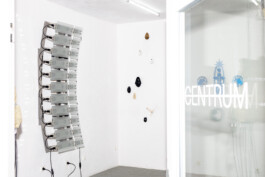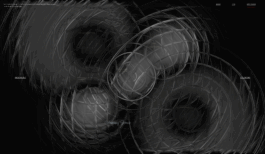Arrhythmia
Arrhythmia was curated by Niki Danai Chania, Niki Maria Lore, and the collective +++. It took place under the umbrella of 48 Hours Neukölln Festival.
27-29 June 2025 at Centrum Berlin
Exhibition works by Canvaswan, Orestis Telemachou & Shao-Chun Hsu, Tony Tao Li, ULTRA (Benze De Ream & Tonda Budszus), Niki Danai Chania, Niki Maria Lore (Niki Pielsticker), Zuzana Pabisova.
Exhibition’s soundscape/performances by Neda, Gabrielle Rose, Reinartz, ôolong, Mondame, slyn, c00stanza + Noemi Calzavara, Morfvoz.

Program of Sound (/) Performances:
Friday 27 June
21:00 Elif Gülin Soğuksu (live set)
Saturday 28 June
16:00 Gabrielle Rose (dj set)
17:00 Reinartz (live set)
18:00 ôolong (dj set)
20:00 Mondame (live set)
Sunday 29 June
16:30 Ashlynn (dj set)
18:00 c00stanza & Noemi Calzavara (dance / live)
19:00 Morfvoz (live set)
Media:
kaltblut magazine
48h neukölln
gallerytalk
artrabbit
Arrhythmia was curated by Niki Danai Chania, Niki Maria Lore, and the collective +++. It took place under the umbrella of 48 Hours Neukölln Festival.
27-29 June 2025 at Centrum Berlin
Exhibition works by Canvaswan, Orestis Telemachou & Shao-Chun Hsu, Tony Tao Li, ULTRA (Benze De Ream & Tonda Budszus), Niki Danai Chania, Niki Maria Lore (Niki Pielsticker), Zuzana Pabisova.
Exhibition’s soundscape/performances by Neda, Gabrielle Rose, Reinartz, ôolong, Mondame, slyn, c00stanza + Noemi Calzavara, Morfvoz.
Program of Sound (/) Performances:
Friday 27 June
21:00 Elif Gülin Soğuksu (live set)
Saturday 28 June
16:00 Gabrielle Rose (dj set)
17:00 Reinartz (live set)
18:00 ôolong (dj set)
20:00 Mondame (live set)
Sunday 29 June
16:30 Ashlynn (dj set)
18:00 c00stanza & Noemi Calzavara (dance / live)
19:00 Morfvoz (live set)
Media:
kaltblut magazine
48h neukölln
gallerytalk
artrabbit
an ironic, deliberate provocation: what happens when the demand to “be nice” suppresses the messiness of rage, conflict, and the potential of hate? Drawing from experiences with intimacy and rupture, the installation traces a trajectory — rage / hate >> conflict / break >> repair / change — to ask whether hate can be destructive and constructive, personal and political.
Where disdain equals indifference and superiority, sustaining domination, hate carries another potential: as resistance, as refusal, as a spark of change. (Şeyda Kurt, 2023, Hass. Von der Macht eines widerständigen Gefühls)
an ironic, deliberate provocation: what happens when the demand to “be nice” suppresses the messiness of rage, conflict, and the potential of hate? Drawing from experiences with intimacy and rupture, the installation traces a trajectory — rage / hate >> conflict / break >> repair / change — to ask whether hate can be destructive and constructive, personal and political.
Where disdain equals indifference and superiority, sustaining domination, hate carries another potential: as resistance, as refusal, as a spark of change. (Şeyda Kurt, 2023, Hass. Von der Macht eines widerständigen Gefühls)
Arrhythmia
Arrhythmia was curated by Niki Danai Chania, Niki Maria Lore, and the collective +++. It took place under the umbrella of 48 Hours Neukölln Festival.
27-29 June 2025 at Centrum Berlin
Exhibition works by Canvaswan, Orestis Telemachou & Shao-Chun Hsu, Tony Tao Li, ULTRA (Benze De Ream & Tonda Budszus), Niki Danai Chania, Niki Maria Lore (Niki Pielsticker), Zuzana Pabisova.
Exhibition’s soundscape/performances by Neda, Gabrielle Rose, Reinartz, ôolong, Mondame, slyn, c00stanza + Noemi Calzavara, Morfvoz.

Program of Sound (/) Performances:
Friday 27 June
21:00 Elif Gülin Soğuksu (live set)
Saturday 28 June
16:00 Gabrielle Rose (dj set)
17:00 Reinartz (live set)
18:00 ôolong (dj set)
20:00 Mondame (live set)
Sunday 29 June
16:30 Ashlynn (dj set)
18:00 c00stanza & Noemi Calzavara (dance / live)
19:00 Morfvoz (live set)
Media:
kaltblut magazine
48h neukölln
gallerytalk
artrabbit
Arrhythmia was curated by Niki Danai Chania, Niki Maria Lore, and the collective +++. It took place under the umbrella of 48 Hours Neukölln Festival.
27-29 June 2025 at Centrum Berlin
Exhibition works by Canvaswan, Orestis Telemachou & Shao-Chun Hsu, Tony Tao Li, ULTRA (Benze De Ream & Tonda Budszus), Niki Danai Chania, Niki Maria Lore (Niki Pielsticker), Zuzana Pabisova.
Exhibition’s soundscape/performances by Neda, Gabrielle Rose, Reinartz, ôolong, Mondame, slyn, c00stanza + Noemi Calzavara, Morfvoz.
Program of Sound (/) Performances:
Friday 27 June
21:00 Elif Gülin Soğuksu (live set)
Saturday 28 June
16:00 Gabrielle Rose (dj set)
17:00 Reinartz (live set)
18:00 ôolong (dj set)
20:00 Mondame (live set)
Sunday 29 June
16:30 Ashlynn (dj set)
18:00 c00stanza & Noemi Calzavara (dance / live)
19:00 Morfvoz (live set)
Media:
kaltblut magazine
48h neukölln
gallerytalk
artrabbit
be nice
sound installation, sculpture
Becoming Otherwise, Esto Association and okay.space, a Collective of Collectives Festival, Athens, Greece
2025
Arrhythmia
exhibition in collaboration with artist Niki Danai Chania and collective +++
Centrum Berlin
2025
Died of a Broken Heart
sound installation
2025
Dark Siren
sound installation made in collaboration with sound artist Paolo Piaser
Dutch Design Week x GS24
2024
Gijs Bakker Award Nominee
Collapsing Sirens
design research
DAE master thesis
2024





be nice
sound installation, sculpture
Becoming Otherwise, Esto Association and okay.space, a Collective of Collectives Festival, Athens, Greece
2025
Arrhythmia
exhibition in collaboration with artist Niki Danai Chania and collective +++
Centrum Berlin
2025
Died of a Broken Heart
sound installation
2025
Dark Siren
sound installation made in collaboration with sound artist Paolo Piaser
Dutch Design Week x GS24
2024
Gijs Bakker Award Nominee
Collapsing Sirens
design research
DAE master thesis
2024
nikilore@gmail.com
@nikimarialore
2024 Design Academy Eindhoven, Netherlands
Critical Inquiry Lab, MA
2020 University of the Arts, Berlin, Germany
GWK - Communication in Social and Economic Contexts, BA

nikilore@gmail.com
@nikimarialore
2024 Design Academy Eindhoven, Netherlands
Critical Inquiry Lab, MA
2020 University of the Arts, Berlin, Germany
GWK - Communication in Social and Economic Contexts, BA